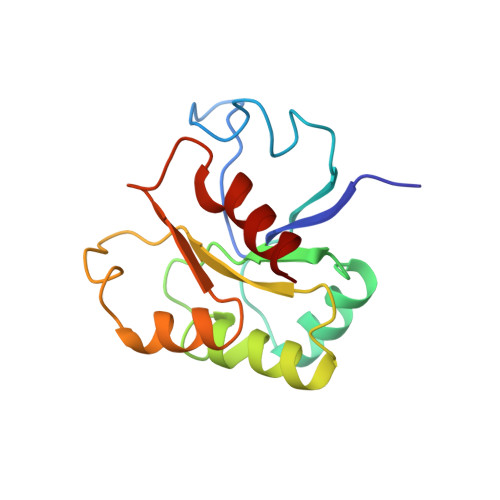Structure and dynamics of the B12-binding subunit of glutamate mutase from Clostridium cochlearium.
Hoffmann, B., Konrat, R., Bothe, H., Buckel, W., Krautler, B.(1999) Eur J Biochem 263: 178-188
- PubMed: 10429202
- DOI: https://doi.org/10.1046/j.1432-1327.1999.00482.x
- Primary Citation of Related Structures:
1B1A - PubMed Abstract:
Glutamate mutase (Glm) is an adenosylcobamide-dependent enzyme that catalyzes the reversible rearrangement of (2S)-glutamate to (2S, 3S)-3-methylaspartate. The active enzyme from Clostridium cochlearium consists of two subunits (of 53.6 and 14.8 kDa) as an alpha2beta2 tetramer, whose assembly is mediated by coenzyme B12. The smaller of the protein components, GlmS, has been suggested to be the B12-binding subunit. Here we report the solution structure of GlmS, determined from a heteronuclear NMR-study, and the analysis of important dynamical aspects of this apoenzyme subunit. The global fold and dynamic behavior of GlmS in solution are similar to those of the corresponding subunit MutS from C. tetanomorphum, which has previously been investigated using NMR-spectroscopy. Both solution structures of the two Glm B12-binding subunits share striking similarities with that determined by crystallography for the B12-binding domain of methylmalonyl CoA mutase (Mcm) from Propionibacterium shermanii, which is B12 bound. In the crystal structure a conserved histidine residue was found to be coordinated to cobalt, displacing the endogenous axial ligand of the cobamide. However, in GlmS and MutS the sequence motif, Asp-x-His-x-x-Gly, which includes the cobalt-coordinating histidine residue, and a predicted alpha-helical region following the motif, are present as an unstructured and highly mobile loop. In the absence of coenzyme, the B12-binding site apparently is only partially formed. By comparing the crystal structure of Mcm with the solution structures of B12-free GlmS and MutS, a consistent picture on the mechanism of B12 binding has been obtained. Important elements of the binding site only become structured upon binding B12; these include the cobalt-coordinating histidine residue, and an alpha helix that forms one side of the cleft accommodating the nucleotide 'tail' of the coenzyme.
Organizational Affiliation:
Institut of Organic Chemistry, University of Innsbruck, Innsbruck, Austria.














